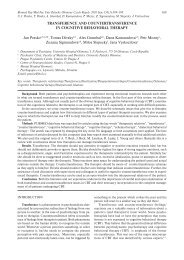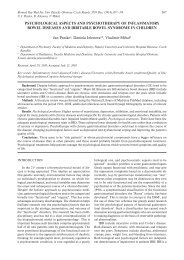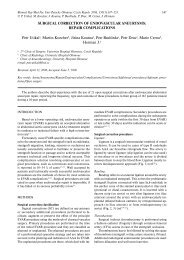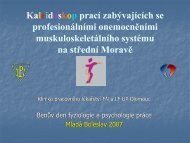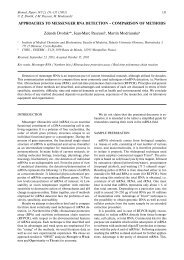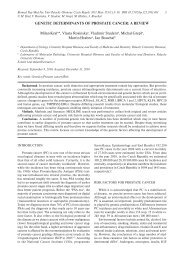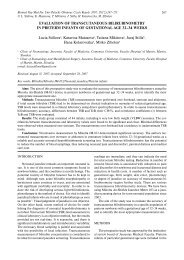TISSUE AND PLASMA CONCENTRATIONS OF ANTIBIOTIC ...
TISSUE AND PLASMA CONCENTRATIONS OF ANTIBIOTIC ...
TISSUE AND PLASMA CONCENTRATIONS OF ANTIBIOTIC ...
Create successful ePaper yourself
Turn your PDF publications into a flip-book with our unique Google optimized e-Paper software.
Biomed Pap Med Fac Univ Palacky Olomouc Czech Repub. 2008, 152(1):139–145.© M. Pojar, J. Mandak, J. Malakova, I. Jokesova139<strong>TISSUE</strong> <strong>AND</strong> <strong>PLASMA</strong> <strong>CONCENTRATIONS</strong> <strong>OF</strong> <strong>ANTIBIOTIC</strong> DURING CARDIACSURGERY WITH CARDIOPULMONARY BYPASS – MICRODIALYSIS STUDYMarek Pojar a *, Jiri Mandak a , Jana Malakova b , Iveta Jokesova baDepartment of Cardiac Surgery, Charles University in Prague, Faculty of Medicine and University Hospital in HradecKrálové, Czech RepublicbInstitute of Clinical Biochemistry and Diagnostics, Charles University in Prague, Faculty of Medicine and UniversityHospital in Hradec Králové, Czech Republice-mail: marek.pojar@centrum.czReceived: February 20, 2008; Accepted (with revisions): May 15, 2008Key words: Microdialysis/Antibiotic concentrations/Target site/Cardiopulmonary bypass/Cardiac surgeryAim: Surgical-site infections are very serious complications of cardiac operations. Use of cardiopulmonary bypass(CPB) is associated with profound physiological changes, which affects the pharmacokinetic behaviour of prophylacticantibiotics. The aim of this study was to monitor tissue concentrations of cefuroxime in peripheral tissue (skeletalmuscle) during cardiac surgery using CPB by means of a microdialysis.Methods: Eleven adult patients operated on using CPB were included in the study. Cefuroxime was the prophylacticantibiotic and study drug given. Microdialysis was performed by probe CMA 60 inserted into the patient’s leftdeltoid muscle. Samples of dialysates were collected at intervals: before CPB, each 30 minutes of CPB and at the endof CPB. Samples of blood were collected at intervals: incision, start of CPB, each 30 minutes of CPB, at the end ofCPB and at the end of surgery.Results: The mean (± S.D.) concentrations of cefuroxime in peripheral tissue were 105.4±41.1, 81.7±32.8, 74.6±26.0,70.4±34.7, 60.5±27.2, 138.0±42.6 (mg l -1 ). Total plasma concentrations of cefuroxime were 154.4±41.6, 73.3±20.7,67.1±20.4, 59.2±21.0, 49.0±16.4, 110.9±33.6 (mg l -1 ) and concentrations of free plasma fraction were 110.7±37.1,62.2±18.8, 58.9±18.6, 48.4±16.6, 41.7±15.6, 97.6±28.6 (mg l -1 ). The plasma and tissue concentrations exceed throughoutthe operation time the minimum inhibitory concentration for most common suspected pathogens in cardiacsurgery.Conclusions: Results show that CPB can modify the time course of cefuroxime tissue and plasma concentrations.Microdialysis is suitable for antibiotic tissue measurement in cardiac surgery.INTRODUCTIONWound and mediastinal infections along with postoperativeendocarditis are very serious complications of cardiosurgical operations with life-threatening consequencesfor the patient. The incidence of sternal infection aftercardiac operations ranges from 0.9 % to 20 % in variousstudies and the incidence of mediastinitis is 1–2 % inmost reports 1 . The mortality rate for patients with deepsternal infections ranges from 9.8 to 14 % 2 . These infectiouscomplications require repeated surgical interventionaccompanied by aggressive pharmacological treatment.To reduce the risk of such sequellae, for several years,prophylactic use has been made of intravenous antibioticsin patients undergoing cardiac surgery 3 . The aim of theprophylaxis is to achieve levels of the free plasma andtarget site concentrations of antibiotic (ATB) in soft tissue,which exceed the minimum inhibitory concentration(MIC) for the most common suspected pathogens andto maintain these concentrations throughout the operation.Common suspected pathogens are usually Grampositivecocci, Staphylococcus aureus and Staphylococcusepidermidis (coagulase-negative staphylococcus).Cephalosporins (beta-lactam antibiotics) are frequentlyused in cardiac surgery for their broad spectrum of activityand low degrees of toxicity 4, 5 .The question is whether antibiotic prophylaxis currentlypracticed in cardiac surgery provides suffi cientprotection during cardiac surgery and in the postoperativeperiod. Studies on antibiotic prophylaxis and the useof extra-corporeal circulation are based on evaluation ofantibiotic concentrations in serum. Recent studies haveindicated that target site concentrations of antibiotics insoft tissues may be inadequate and subinhibitory, despiteadequate plasma concentrations 6, 7 . Suboptimal, subinhibitory,target site concentration of antibiotic may explainantibiotic prophylaxis failure despite recorded in vitrosusceptibility to suspected microorganism and adequateplasma concentrations.The use of cardiopulmonary bypass (CPB) is associatedwith profound physiological changes and alteredprotein binding. CPB can thus modify the distribution ofantibiotics 8, 9 . As a result there can be inadequate antibioticconcentration with a higher risk of infectious complications.The present study was designed to measure unbound(microbiologically active) concentrations of β-lactam antibioticsin the interstitial space fluid of soft tissue during
140 M. Pojar, J. Mandak, J. Malakova, I. Jokesovasurgery with CPB and to relate these concentrations tocorresponding plasma levels.A new method that allows continuous measurementof unbound antibiotic concentration in the peripheralspace of the tissue is microdialysis. We measured interstitialconcentrations of cefuroxime by means of in vivomicrodialysis.MATERIAL <strong>AND</strong> METHODSThe study was carried out at the Cardiac SurgeryDepartment, University Hospital and Medical Faculty inHradec Králové, Charles University in Prague. The localethics committee at the University Hospital in HradecKrálové, in accordance with the Declaration of Helsinki,approved the study. All subjects were given a detailed descriptionof the study, and their written informed consentwas obtained.PatientsEleven patients (9 male, 2 female) were included inthe study. All patients underwent elective cardiac surgeryprocedure in CPB. Patients were excluded from the studyif they had received any treatment with any antibioticswithin the 14 days prior to the start of the study, or hadallergic or hypersensitive reaction to β-lactam antibioticsin their history. Patients with an active infection or renalfailure, and patients operated on as emergencies were alsoexcluded.Cardiopulmonary bypass and surgical procedureThe anaesthetic management, CPB and surgical procedureswere standardized. Food and fl uid intake wasdiscontinued at midnight on the day preceding surgery.Anaesthesia was induced with intravenous thiopental ormidazolam and sufentanyl, muscle relaxation with cisatracurium.Anaesthesia was maintained by infusion ofcisatracurium, sufentanyl and propofol and dose changeswere made to keep the patient adequately anaesthetizedand hemodynamically stable. Isoflurane was added in oxygen.Standard adult extracorporeal tubing set was used incorporatinga 40 μm arterial fi lter. The extracorporealcircuit consisted of a hollow fi bre membrane oxygenatorwith integral heat exchanger (D903 AVANT, Dideco,Mirandola, Italy) and a roller pump with non-pulsatileflow (Stöckert S3, Sorin Group, Munich, Germany). Theoxygenator and tubing were primed with a mixture of crystaloidand coloid solutions. No antibiotics were added tothe prime solution. Anticoagulation was induced beforeCBP with heparin (2.5 mg kg –1 ), and the activated clottingtime (ACT) was monitored. Additional doses of heparinwere given to maintain ACT time over 480 seconds. AfterCPB, heparin was neutralized with protamine sulphate ata 1:1 ratio. After median sternotomy and pericardotomystandard aortic cannula and two-stage venous cannula(inserted into the inferior vena cava through the rightatrium) were used. CPB involved normotermia and calculatedblood flow of 2.4 l m -2 min -1 . Mean arterial pressure(MAP) during CPB was maintained at 50 to 75 mmHg,hematocrit was above 20 %. The acid base status wasmaintained using the alpha-stat perfusion strategy. Afterthe aorta had been cross-clamped, cardiac arrest was initiatedby the antegrade infusion of cold crystalloid potassiumcardioplegia (St. Thomas solution, Ardeapharma,Ševětín, Czech Republic), repeated every 20 minutes andtopical cooling for myocardial protection was employed.Measurement of interstitial antibiotic concentration,microdialysisMicrodialysis is a minimally invasive technique basedon the sampling of unbound molecules from the extracellularspace (interstitial fluid) of tissue by means of asemipermeable membrane at the tip of a microdialysisprobe. The basic principle is to mimic the function of acapillary blood vessel. The probe is constantly perfusedwith physiological solution at a constant low flow rate.Substances present in the interstitial fluid surroundingthe microdialysis probe at concentration (c tissue) diffusethrough the membrane into the probe, resulting in a concentration(c dialysate) in the perfusion medium. Samples ofthe microdialysates are collected and analysed.For most analytes the equilibrium between interstitiumand perfusion medium is incomplete, and thereforec tissueis greater than c dialysate. For in vivo quantitative measurementthe microdialysis probe needs to be calibrated.The calibration factor by which the concentrations areinterrelated is termed „recovery“ (recovery (%) = c dialysatex c tissue-1x 100).To obtain an absolute drug concentration in the interstitialfl uid from the concentration measured in thedialysate, in vivo recovery was assessed in each experimentby the retrodialysis method. The principle of thismethod relies on the fact that the diffusion process isquantitatively equal in both directions through the semipermeablemembrane. Cefuroxime was added to the perfusionmedium (Ringer’s solution, Braun Melsungen AG,Melsungen, Germany: Na + 147 mmol l -1 , K + 4 mmol l -1 ,Ca +2 2.25 mmol l -1 , Cl –1 156 mmol l -1 , 309 mosmol l -1 ) andits rate of disappearance through the membrane was takenas the in vivo recovery 6, 10, 11 . The in vivo recovery valuewas calculated as: recovery (%) =100 – (100 x analyteconcentration dialysatex analyte concentration perfusate-1).Antibiotic prophylaxis regimens and study drugCefuroxime (Axetine, Medochemie Ltd., Limassol,Cyprus), second generation cephalosporin, was used as aprophylactic, study, antibiotic (1.5 g cefuroxime in 20 mlNaCl administered as a bolus injection through a centralvein catheter). Antibiotic prophylaxis was given in accordancewith the standard protocol of our cardiac centre.The first dose was administered (cefuroxime 3.0 g) at thetime of anaesthesia induction, the second dose (1.5 g) atthe same time as protamine infusion after removing theaortic perfusion cannula (end of CPB), the third dose(1.5 g) after 8 hours (in case of revascularisation procedures),and every 8 th hour up to 48 hours postoperatively(procedures on the valves).
Tissue and plasma concentrations of antibiotic during cardiac surgery with cardiopulmonary bypass– microdialysis study141Fig. 1. Microdialysis catheter is just inserted into the leftdeltoid muscle.Fig. 2. Cefuroxime tissue concentrations (mg l -1 ). Mean± S.D. CPB- cardiopulmonary bypass.Fig. 3. Plasma concentrations of cefuroxime – total andfree (unbound) fraction (mg l -1 ). Mean ± S.D.CPB- cardiopulmonary bypass.Study protocolThe patients remained in a supine position throughoutthe study period. Before the operation procedure onecommercially available microdialysis probe (CMA 60;CMA Microdialysis AB, Solna, Sweden) with a molecularweight cut-off of 20,000 Dalton and a polyamide membranelength of 30 mm (0.6 mm in diameter) was insertedunder sterile conditions into the skeletal muscle tissue(left deltoid muscle) without prior anaesthesia (Fig. 1).The microdialysis probe was connected and constantlyperfused with Ringer´s solution at a constant flow rateof 0.1 ml h -1 by means of a precision pump (Pilote A2IS2, Fresenius Vial, Le Grand Chemin, Brezins, France).Prior to the systemic administration of the study drug,after a 30-min. baseline sampling period, in vivo probecalibration was done. As described previously, the microdialysisprobe was flushed with a solution of the drug for30 minutes to obtain individual the in vivo recovery valueby means of the retrodialysis method. After a sufficientwashout period for the system with Ringer’s solution, thefirst dose of cefuroxime (3.0 g) was administered in theperiod of anaesthesia induction.Fig. 4. In vitro calibration of the microdialysis probefor cefuroxime. Cefuroxime concentrations weremeasured in the dialysate and in the surroundingmedium. The linear regression indicates a consistentrelationship between the concentration in surroundingsolution and in the dialysate over a wideconcentration range. The vertical and horizontallines illustrate the method for determining the invitro recovery, which was 89 % for cefuroxime.Fig. 5. Changes of the protein binding value during cardiacsurgery with cardiopulmonary bypass. Mean± S.D. CPB-cardiopulmonary bypass.
142 M. Pojar, J. Mandak, J. Malakova, I. JokesovaSampling of microdialysates at 30-min. intervals wasperformed at defined time intervals throughout the operationprocedure (1- skin incision, before CPB, 2-5 - duringCPB, 6 – wound closure, after CPB, Fig. 2). Blood samples(2 ml) from the arterial catheter were sampled duringthe operation procedure (1- skin incision, 2- beginningof CPB, 3–5 - every 30-min. during CPB, 6- end of theoperation, wound closure, Fig. 3). After the microdialysisprocedure, the probe was removed. The lag time due tothe dead volume between microdialysis membrane andthe point of dialysate collection was taken into account.Microdialysis samples were stored at –80 °C untilanalysis. Blood samples were collected in tubes containingethylenediaminetetraacetic acid (EDTA) as an anticoagulant,centrifuged and plasma samples were stored at–80 °C until analysis.Probe in vitro recovery calculationTo obtain basic data on the microdialysis probe functionapropos the transport of cefuroxime via its semipermeablemembrane, probe recovery was determined invitro. The probe was immersed in 100 ml of cefuroximesolution (different concentrations of cefuroxime) at a constanttemperature (25 °C) and perfused with Ringer’s solutionat a flow rate of 0.1 ml h -1 . Analytes were measuredin the dialysate, and the results were plotted against theconcentrations in the surrounding medium (Fig. 4).Drug analysisStandard procedures were used for measuring drugconcentrations in plasma (free and total) and in themicrodialysate. High-performance liquid chromatography(HPLC) with UV photodiode-array detection (PDA) fordetermination of cefuroxime in plasma samples and insamples from microdialysis was developed and validated.The detection of cefuroxime was performed on a PDA detectorat 254 nm. The procedure in samples from in vivomicrodialysis included only the addition of the internalstandard cefoxitin before HPLC separation. The unboundcefuroxime fraction in plasma was obtained using ultrafiltrationmethod on column Microcon YM 10 (Amicon).Calculation and data analysisAs described above, drug equilibration between interstitialfluid and perfusion solution is incomplete.Therefore the concentrations of study drug, measured inmicrodialysate samples, were corrected by the followingequation to obtain free drug concentration in the extracellularspace in the soft tissue: c extracellular= 100 x (c dialysatex invivo recovery (%) -1 ).Demographic and perioperative parameters wereanalysed by descriptive methods (mean ± standard deviationS.D.); drug concentrations are expressed as mean± S.D.RESULTSThe pre and perioperative characteristics of the elevenpatients are recorded in table 1. Seven patients underwentrevascularization and in four patients the valve replacementprocedure was used. None suffered from postoperativesurgical site infection.Initial concentrations, both plasma and tissue concentrations,were gradually decreased after the start ofCPB and lasted until CPB ended. Further increase in thevalues could be seen after the application of the seconddose of antibiotic at the time of protamine administration(sampling interval 6). The time course of the freecefuroxime concentrations in the interstitial space for theTable 1. Preoperative and perioperative characteristics.Mean ± S.D. Min. Max.Age (y) 65.5 ± 11.0 44 81Weight (kg) 75.1 ± 12.2 50 91Height (cm) 171.7 ± 9.8 153 181Body mass index 25.4 ± 3.1 19.5 29.11 st dose of ATB (mg kg -1 ) 41.1 ± 7.8 33.0 60.01 st dose of ATB (mg cm -2 ) 1631.2 ± 188.6 1415.1 2013.4Operation time (min) 189.1 ± 39.2 130 245CPB time (min) 87.8 ± 21.9 53 132Prime volume of CPB (ml) 1538.2 ± 220.6 1200 1950Preoperative serum creatinine (μmol l -1 ) 101.5 ± 21.2 77 143Preoperative serum urea (mmol l -1 ) 5.6 ± 1.8 2.8 8.8ATB – antibiotic; CPB – cardiopulmonary bypass; S.D. – standard deviation
Tissue and plasma concentrations of antibiotic during cardiac surgery with cardiopulmonary bypass– microdialysis study143skeletal muscle during cardiac surgery with CPB is shownin Fig. 2. The mean concentration-versus-time profile (totaland free concentration) of cefuroxime in plasma isdepicted in Fig. 3.The values of cefuroxime in plasma and in the interstitialfluid exceeded the “MICs”, the minimum inhibitoryconcentrations (Gram-positive bacteria 2 mg l -1 , Gramnegativebacteria 4 mg l -1 ), throughout the course of thecardiac surgery. Even after 120 minutes of CPB (in threecases) the levels were sufficient and higher than recommendedinhibitory concentrations.The results of the in vitro probe recovery study are depictedin Figure 4. There was a linear correlation betweencefuroxime concentrations in the dialysate and surroundingmedium over a wide concentration range.The protein binding values of cefuroxime were calculatedfrom total and free plasma concentrations. Themean protein binding fraction before the institution ofthe bypass was 29.0 % and decreased to 15.6 % after theinitiation of CPB and remained at this level throughoutthe bypass period (Fig. 5).DISCUSSIONThe present study is the first to evaluate tissue concentrationsof prophylactically administered antibioticsduring cardiac surgery with CPB by means of a bioanalyticalsampling technique, interstitial microdialysis. Wedetermined cefuroxime concentrations in the interstitialfluid of the peripheral muscle and in the plasma.Antibiotic prophylaxis against bacterial infections hasbecome the standard method for protecting patients duringcardiac surgery and in the early postoperative period.The prophylaxis aims to achieve plasma and, above all,tissue levels of antibiotic, which at the time of the operationexceed the minimum inhibitory concentration forthe pathogens. The number of resistant microorganismsis increasing, particularly the beta-lactamase producinggram-negative organisms, which have the ability to destroymany penicillins and cephalosporins. The reason for developmentof resistance may be the long-term applicationof antibiotics and ineffective dose regimens. Clinical andexperimental studies have shown that for optimal antibioticeffect it is necessary to achieve high concentrationsin plasma and tissues during the operative procedure,which is the time of maximal contamination 3 . In cardiacsurgery it is mainly in the period of clot forming after theadministration of the protamine and in the phase of thewound closure.Antibiotics are substances, which can be partiallybound to plasma proteins or to the blood cells, or theymay diffuse into the blood cells. A portion remains unbound.Free antibiotic concentrations in the interstitialfluid at the target site are responsible for the antibacterialeffect and may be more relevant in predicting therapeuticefficiency than plasma concentrations 12, 13 . As known, inthe case of soft tissue infections (wound infections) bacteriaare localized in the fluid of the interstitial space. Inorder to achieve a prophylactic effect of an antibiotic, thedecisive factor is the concentration of the antibiotic in theextracellular space of the soft tissue. An insufficient levelof the antibiotic in the target site may be thus one of thereasons for the anti-infectious therapy failure and developmentof drug resistance. Several papers have presentedthe results of microdialysis studies on antibiotic concentrationsin the soft tissue. Brunner and colleagues 10 ,Joukhadar et al. 14 and Zeitlinger et al. 15 described altered orinsufficient (subinhibitory) concentrations of antibioticsin the tissue in different conditions and tissues. However,none of them deals with antibiotics determination in theperipheral tissue during a cardiosurgical operation withextracorporeal circulation.The use of CPB is associated with profound physiologicalchanges. Haemodilution, hypothermia, redistributionof blood flow in the peripheral tissue, isolation ofthe lungs from the circulation, sequestration in the CPBequipment, decreased renal function, diminished proteinbinding, reduced clearance, changes in volume of distribution,the activation of the systemic inflammatory reactionare factors that may alter the pharmacokinetic behaviourof antibiotics 16-18 .In the past various methods were developed to quantifythe penetration of antibiotics into soft tissue, but majordisadvantages of the these methods (skin blister fluidmethod, biopsy and the tissue homogenisation, imagingprocedures such as a positron emission tomography ormagnetic resonance imaging) are limitations for tissuepharmacokinetic studies as well as inability to discriminatebetween free and bound fractions 19, 20 .In the present study, we used in vivo microdialysismeasurement of antibiotic tissue concentrations duringthe cardiac operation. This method is a new tool for monitoringfree drug concentrations (e.g. an antibiotic) in theperipheral tissue directly and continuously. We selectedthe deltoid muscle as a typical peripheral tissue for insertionof the catheter. This typical skeletal, peripheralmuscle is easily accessible and avoids disturbing the sterileconditions (for handling by microvials) throughout thecourse of the cardiac surgery. Despite the probe being insitu for up to approximately 8 hours, no complications orside effects with the microdialysis were found.As a prophylaxis, and study drug, we used cefuroxime,because cephalosporins are frequently prescribed forprophylaxis in cardiac surgery 21-23 . The dosing schedulesfor the cephalosporins (cefuroxime) administration asrecommended by the manufacture’s are of general validityand can serve as a basis for prophylactic administrationin general surgical interventions. However, the dosing(amount and intervals) of prophylactically administeredantibiotics in cardiac surgery operations with the use ofextracorporeal circulation is not available. Guidelines alsovary among the cardiac surgery centres. The differences indosing regimen are in the duration (single dose regimenversus multiple-dose application prolonged up to 48 hourspostoperatively), in the timing of the first and the secondadministered dose or the amount of the doses 17, 24, 25 . Inthis study we tried to evaluate our antibiotic prophylaxisregimen with respect to plasma and especially tissue concentrations.
144 M. Pojar, J. Mandak, J. Malakova, I. JokesovaThe results of this pilot microdialysis study showeddynamic changes in the concentrations of cefuroxime thatdepend on the phase of the surgery using cardiopulmonarybypass (Figs. 2, 3). We found that muscle concentrationsof cefuroxime after the administration reflectedplasma concentrations. Both plasma and muscle concentrationsof cefuroxime were higher than MICs, the minimuminhibitory concentrations, throughout the course ofthe surgery. Supported by our data, the practice of 3 g ofcefuroxime administration with anaesthesia induction and1.5 g of cefuroxime after CPB provides effective antibacterialconcentrations in plasma and skeletal tissue duringcardiac surgery with cardiopulmonary bypass. From ourdata, it seems that administration of the second dose afterthe end of the CPB is not necessary. However, we recommendthe second dose of antibiotic with protamine infusionin order to obtain maximum antibiotic concentrationin newly formed blood clots.Higher concentrations of cefuroxime in the skeletalmuscle during the CPB than plasma concentrations werefound in this study. One explanation could be profoundphysiological changes during CPB. These are closely associatedwith haemodilution, changes in capillary integrityand a shift of intravascular volume to the extravascularspace. Further, the changes in protein binding, which wehave noted (Fig. 5), could explain these differences. Thedecrease in protein binding upon initiation of the bypasscould result in potentionally greater transfer of antibioticto the tissue. In addition, decreased clearance and enhancedvolume of distribution for the cephalosporins havebeen described 26, 27 .From a practical point of view, we used a standarddose of cefuroxime for each patient regardless of bodyweight.The calculated dose of the cefuroxime rangedfrom 33.0 to 60.0 mg kg -1 (the first dose). We found nosimple correlation between the plasma or tissue concentrationsand dose, body-weight, body mass index, bodysurface area or priming volume of the CPB.Evaluation of the subcutaneous interstitial concentrationsof the suprasternal region, near to the incision, isthe next step to improve the prophylaxis regimen. This isthe typical region for surgical site infections in cardiac surgery,with insufficient blood perfusion of the subcutis.CONCLUSIONSIn conclusion, interstitial microdialysis proved to bean excellent method for monitoring unbound substancesin peripheral tissue and it promises to lead to greaterknowledge on the distribution of drugs in target tissuesduring surgery.In this study, the decrease in drug concentrations occurredat the start of CPB and lasted until the end of CPB.The increase in plasma concentrations corresponded withthe second dose of drug after CPB. The distribution wasinfluenced by changes during CPB such as haemodilution,alterations in tissue perfusion, capillary fluid pressure andinconstant protein-binding values.ACKNOWLEDGMENTSThis study was supported by the Research Project MZO00179906, Czech Republic.REFERENCES1. Tegnell A, Arén C, Öhman L. Coagulase-negative staphylococciand sternal infections after cardiac operation. Ann Thorac Surg2000; 69:1104-09.2. Ridderstolpe L, Gill H, Granfeldt H, Ahlfeldt H, Rutberg H.Superficial and deep sternal wound complications: incidence, riskfactors and mortality. Eur J Cardiothorac Surg 2001; 20:1168-75.3. Kriaras I, Michalopoulos A, Turina M, Geroulanos S. Evolutionof antimicrobial prophylaxis in cardiovascular surgery. Eur JCardiothorac Surg 2000; 18:440-46.4. Curtis JJ, Boley TM, Walls JT, Hamory B, Schmaltz RA.Randomized, prospective comparison of first- and second-generationcephalosporins as infection prophylaxis for cardiac surgery.Am J Surg 1993; 166:734-37.5. Townsend TR, Reitz BA, Bilker WB, Bartlett JG. Clinical trial ofcefamandole, cefazolin, and cefuroxime for antibiotic prophylaxisin cardiac operations. J Thorac Cardiovasc Surg 1993; 106:664-70.6. Bellmann R, Kuchling G, Dehghanyar P, Zeitlinger M, Minar E,Mayer BX et al. Tissue pharmacokinetics of levofloxacin in humansoft tissue infections. Br J Clin Pharmacol 2004; 57:563-68.7. Tomaselli F, Dittrich P, Maier A, Woltsche M, Matzi V, Pinter Jet al. Penetration of piperacillin and tazobactam into pneumonichuman lung tissue measured by in vivo microdialysis. Br J ClinPharmacol 2003; 55:620-24.8. Adrianzén Vargas MR, Danton MH, Javaid SM, Gray J, Tobin C,Brawn WJ et al. Pharmacokinetics of intravenous flucloxacillin andamoxicillin in neonatal and infant cardiopulmonary bypass surgery.Eur J Cardiothorac Surg 2004; 25:256-60.9. Pryka RD, Rodvold KA, Ting W, Levitsky S, Frost RW, LettieriJT. Effects of cardiopulmonary bypass surgery on intravenousciprofloxacin disposition. Antimicrob Agents Chemother 1993;37:2106-11.10. Brunner M, Pernerstorfer T, Mayer BX, Eichler HG, Müller M.Surgery and intensive care procedures affect the target site distributionof piperacillin. Crit Care Med 2000; 28:1754-59.11. Islinger F, Dehghanyar P, Sauermann R, Bürger C, Kloft C, MüllerM et al. The effect of food on plasma and tissue concentrationsof linezolid after multiple doses. Int J Antimicrob Agents 2006;27:108-12.12. Joukhadar C, Klein N, Dittrich P, Zeitlinger M, Geppert A,Skhirtladze K et al. Target site penetration of fosfomycin in criticallyill patients. J Antimicrob Chemother 2003; 51:1247-52.13. Liu P, Müller M, Derendorf H. Rational dosing of antibiotics: theuse of plasma concentrations versus tissue concentrations. Int JAntimicrob Agents 2002; 19:285-90.14. Joukhadar C, Klein N, Mayer BX, Kreischitz N, Delle-Karth G,Palkovits P et al. Plasma and tissue pharmacokinetics of cefpiromein patients with sepsis. Crit Care Med 2002; 30:1478-82.15. Zeitlinger MA, Dehghanyar P, Mayer BX, Schenk BS, Neckel U,Heinz G et al. Relevance of soft-tissue penetration by levofloxacinfor target site bacterial killing in patients with sepsis. AntimicrobAgents Chemother 2003; 47:3548-53.16. Lonský V, Manďák J, Lonská V, Rozsíval V, Marková D, KubíčekJ. Serum oxacilin and cephazolin levels during cardiopulmonarybypass. Perfusion 1992; 7:115-18.17. Vourisalo S, Pokela R, Syrjala H. Is singl-dose antibiotic prophylaxissufficient for coronary artery bypass surgery? An analysis ofperi- and postoperative serum cefuroxime and vancomycin levels.J Hosp Infect 1997; 37:237-47.18. Woods M, LeBlanc K, Gersema L. Antibiotic prophylaxis in cardiothoracicsurgery: result of a second survey. Hosp Pharm 1990;25:641-43.
Tissue and plasma concentrations of antibiotic during cardiac surgery with cardiopulmonary bypass– microdialysis study14519. Müller M, Haag O, Burgdorff T, Georgopoulos A, Weninger W,Jansen B et al. Characterization of peripheral-compartment kineticsof antibiotics by in vivo microdialysis in humans. AntimicrobAgents Chemother 1996; 40:2703-09.20. Tomaselli F, Maier A, Matzi V, Smolle-Jüttner FM, Dittrich P.Penetration of meropenem into pneumonic human lung tissue asmeasured by in vivo microdialysis. Antimicrob Agents Chemother2004; 48:2228-32.21. Gentry LO, Zeluff BJ, Cooley DA. Antibiotic prophylaxis in openheartsurgery: a comparison of cefamandole, cefuroxime, and cefazolin.Ann Thorac Surg 1988; 46:167-71.22. Sisto T, Laurikka J, Tarkka MR. Ceftriaxone vs cefuroxime forinfection prophylaxis in coronary bypass surgery. Scand J ThoracCardiovasc Surg 1994; 28:143-48.23. Slama TG, Sklar SJ, Misinski J, Fess SW. Randomized comparisonof cefamandole, cefazolin, and cefuroxime propylaxis in open-heartsurgery. Antimicrob Agents Chemother 1986; 29:744-47.24. Edwards FH, Engelman RM, Houck P, Shahian DM, Bridges CR.The society of thoracic surgeons practice guideline series: antibioticprophylaxis in cardiac surgery, part I: duration. Ann Thorac Surg2006; 81:397-404.25. Kriaras I, Michalopoulos A, Michalis A, Palatianos G, EconomopoulosG, Anagnostopoulos C et al. Antibiotic prophylaxisin cardiac surgery. J Cardiovasc Surg (Torino) 1997; 38:605-10.26. Buylaert WA, Herrgods LL, Mortier EP, Bogaert MG. Cardiopulmonarybypass and the pharmacokinetics of drugs. An update.Clin Pharmacokinet 1989; 17:10-26.27. Mets B. The pharmacokinetics of anesthetic drugs and adjuvantsduring cardiopulmonary bypass. Acta Anaesthesiol Scand 2000;44:261-73.




